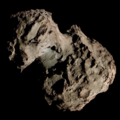 Comet Mellish photographed by Harry E. Wood from the Union Observatory in June 1915 | |
| Discovery | |
|---|---|
| Discovered by | John E. Mellish |
| Discovery date | 10 February 1915 |
| Designations | |
| 1915a [1] 1915 II | |
| Orbital characteristics [2] | |
| Epoch | 30 June 1915 (JD 2420678.5) |
| Observation arc | 376 days (1.03 years) |
| Number of observations | 94 |
| Perihelion | 1.0053 AU |
| Eccentricity | 1.00027 |
| Inclination | 54.792° |
| 73.453° | |
| Argument of periapsis | 247.782° |
| Last perihelion | 17 July 1915 |
| Earth MOID | 0.3339 AU |
| Jupiter MOID | 0.9970 AU |
| Physical characteristics [3] | |
Mean radius | 2.07 km (1.29 mi) [a] |
| Comet total magnitude (M1) | 4.5 |
Comet Mellish, also known formally as C/1915 C1, is one of five comets discovered by American astronomer John E. Mellish. It is a hyperbolic comet that reached perihelion on 17 July 1915. However, just two months earlier, Edward E. Barnard had reported the comet had splitted into three distinct objects on 12 May, [4] later increasing to four by 24 May. [5] In addition, it is thought that this comet was the parent body of the June Lyrids meteor shower, which was first discovered in 1966. [6] [7]



